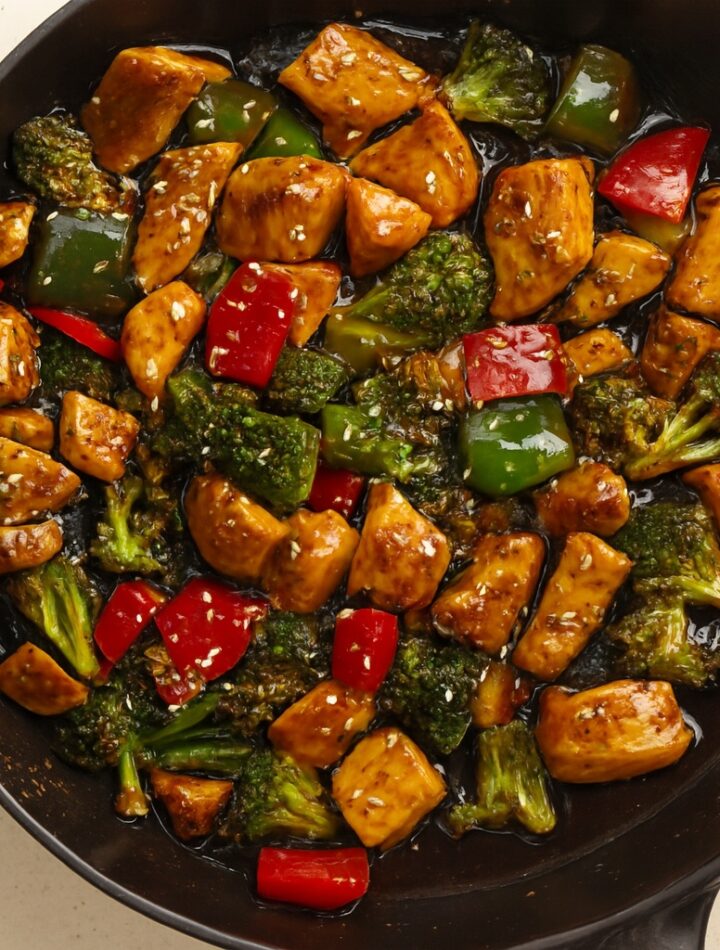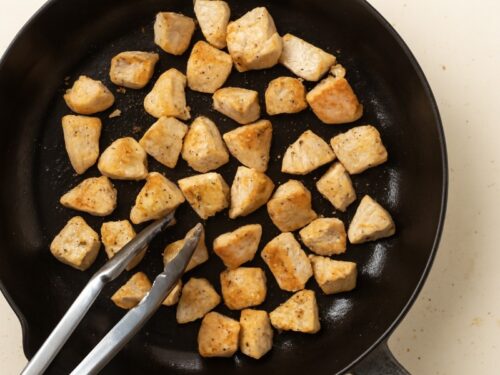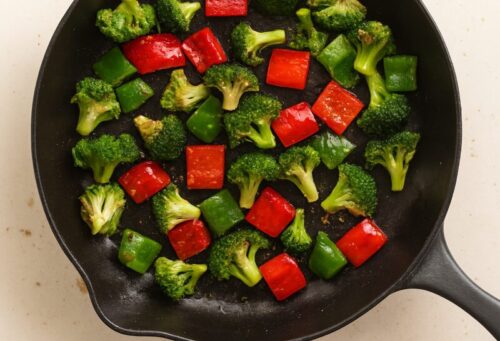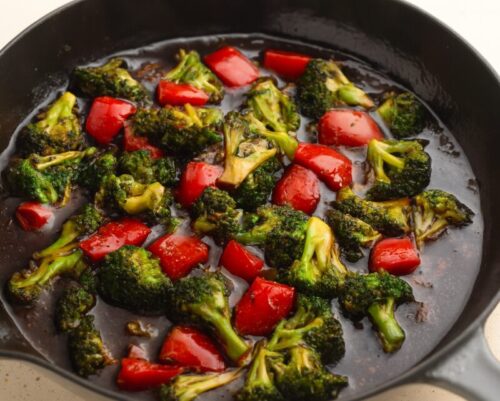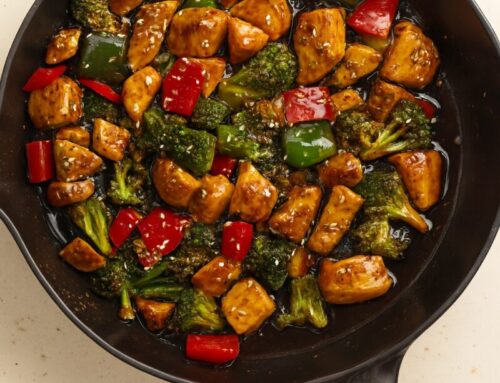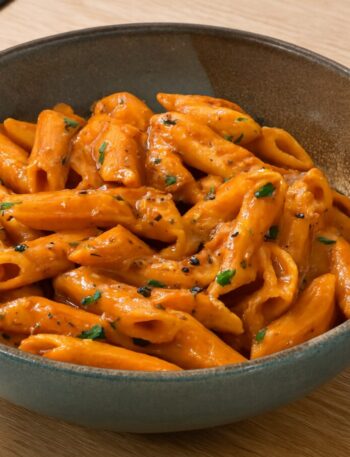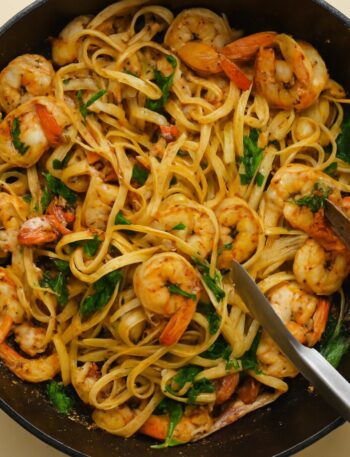So, have you ever tried making teriyaki chicken stir-fry at home?
Like, seriously, I have to say that it’s kinda become my absolute favorite dinner recipe now. It’s one of those things that gets ready in just about 30 minutes, and honestly, it feels way healthier and tastier than ordering takeout.
You’ve got that juicy chicken, then those crunchy veggies, and of course, that sweet-and-salty teriyaki sauce.
Everything just comes together in this perfect balance, you know? I usually serve it with some steamy jasmine rice because, well, it just works. And every single time, the family’s super happy.
Oh, and bonus point is whatever’s left the next day still tastes amazing. Like, really good. So yeah, it’s kinda become a regular thing now.

Teriyaki Chicken Stir Fry
Description
Teriyaki Chicken Stir Fry is a quick, healthy, and tasty dish where soft pieces of chicken are cooked with vegetables and a homemade teriyaki sauce. The sauce is sweet and savory, and it coats everything nicely, making the whole dish flavorful. It comes together fast, so it’s great for busy weeknights or when you want something easy but satisfying. You can serve it with rice or noodles because both work really well. The overall taste feels like something you’d get at a restaurant, but you’re making it right at home.
Ingredients
For the Sauce (Teriyaki Sauce):
For the Stir-Fry (Main Dish):
For Serving (Optional but Recommended):
Instructions
- Start by taking a small bowl and adding all the sauce ingredients: soy sauce, water, honey, brown sugar, rice vinegar, sesame oil, grated ginger, chopped garlic, and cornstarch.
- Whisk everything together really well so the cornstarch dissolves completely as you don’t want any lumps, because that can affect the texture later.
- Make sure the mixture looks smooth and even. Once it’s ready, just keep it aside. This sauce is what gives the dish its main flavor, so it’s good to have it prepared before you start cooking anything else.

- Now take a wide pan and heat about a tablespoon of oil in it.
- Add the small, evenly cut pieces of boneless chicken and sprinkle a little black pepper on top. This step is optional, but it adds a nice bit of flavor.
- Once the chicken looks cooked through and has a slight golden color, take it out of the pan and keep it aside on a plate.
- Let the chicken cook on medium heat for around 5 minutes. Stir occasionally, but also let it sit for a minute or so at the beginning to get a light golden sear.

- In the same pan, add a little more oil and toss in your chopped vegetables like broccoli and capsicum are good choices, but you can use whatever you like.
- Cook the veggies for about 3 to 4 minutes, just enough so they soften slightly but still keep their crunch.
- Don’t cook them too long at this stage, because they’ll continue to cook once the sauce is added. Overcooked veggies can turn mushy and lose their texture.

- Now take the sauce you prepared earlier and pour it into the pan with the veggies. Let it simmer on low to medium heat for about 2 to 3 minutes. Stir gently so it heats evenly and starts to thicken.
- If the sauce becomes too thick, you can add a small splash of water to loosen it up. Keep an eye on the consistency as it should be smooth and able to coat the chicken and veggies nicely.

- Now add the cooked chicken back into the pan with the sauce and veggies. Mix everything well so that the sauce coats all the chicken pieces and vegetables evenly. Let it cook together for another minute so the flavors blend properly.
- Turn off the heat, and sprinkle some toasted sesame seeds on top for a little crunch and extra flavor. That’s it, now serve it hot with jasmine rice, steamed rice, or noodles, depending on what you prefer. You can also garnish with chopped spring onions if you have them.

Step 1: Make the sauce first
Step 2: Cook the chicken
Step 3: Stir-fry the veggies
Step 4: Add the sauce and mix
Step 5: Add the chicken back and finish it off
Pro Tips & Variations
Pro Tips:
- Before you start cooking, take a minute to cut the chicken into small, even-sized pieces. Try to keep them all roughly the same size i.e. not too big, not too tiny. This helps everything cook at the same rate. If some pieces are too thick, they might stay raw inside, and if others are too thin, they could dry out or get tough. So yeah, even cuts make a big difference.
- When you add the chicken to the hot pan, don’t stir it right away. Let it sit for about a minute without touching it. This helps form a light golden layer on the outside, which adds a nice flavor and texture. After that, you can stir and cook it through. If you keep moving it too soon, it won’t get that slight crispiness that makes it taste better.
- Stir-fry cooking goes really fast once you start, so it’s better to have your sauce mixed and ready before turning on the stove. If you try to make the sauce while things are already cooking, you might feel rushed and end up missing steps or overcooking something. Just mix everything in a bowl and keep it nearby as it’ll make the whole process smoother.
- The vegetables should be cooked just enough to soften slightly, but they should still have a bit of crunch. If you cook them too long, they’ll turn mushy and lose their texture. Plus, the dish won’t feel as fresh. So once they start to soften, that’s usually enough, especially since they’ll cook a little more when you add the sauce later.
- Sometimes the sauce thickens more than expected, especially if it sits for a bit or cooks too long. If that happens, just add a spoonful or two of warm water and stir it in, it’ll loosen up quickly. On the other hand, if the sauce feels too thin and watery, you can mix a small amount of cornstarch with water (like a teaspoon or so), then add that to the pan and cook for another minute. It’ll thicken up nicely without changing the flavor.
Variations:
- Swap chicken with cottage cheese or tofu: If you ever want to make a vegetarian version, you can easily replace the chicken with cottage cheese or tofu. Both work really well with the teriyaki sauce and soak up the flavor nicely. Just make sure to cut them into bite-sized cubes and cook them gently so they stay soft and don’t break apart. Tofu might need a little pat-drying before cooking to avoid extra moisture in the pan.
- Veggie-loaded version: You can add extra vegetables like mushrooms, snow peas, carrots, or onions to make the dish more colorful and nutritious. These veggies not only add texture but also bring in different flavors that go well with the sauce. Try to cut them into similar-sized pieces so they cook evenly, and don’t forget to keep them slightly crunchy for the best result.
- Spicy touch: If you enjoy a little heat in your food, you can mix in some red chili flakes or add a small spoon of sriracha sauce. It gives the dish a nice kick without overpowering the other flavors. You can adjust the spice level depending on who’s eating like just taste and tweak as you go.
- Noodle version: Instead of serving it with rice, you can mix the stir-fry with hakka noodles, ramen, or even flat rice noodles. It turns the dish into more of a one-bowl meal and feels a bit like something you’d get at a restaurant. Just make sure the noodles are cooked and drained before adding them to the pan so they don’t get soggy.
- Crunchy garnish: For a little extra texture, sprinkle some roasted peanuts or sesame seeds on top just before serving. It adds a nice crunch and makes each bite more interesting. You can also toast the seeds lightly in a dry pan for a minute to bring out their flavor even more.
Storage & Reheating Instructions
Storage Instructions:
- Use an airtight container: Once the stir-fry cools down to room temperature, transfer it into a clean, airtight container. This helps lock in the moisture and keeps the sauce from drying out. It also prevents the chicken from getting rubbery or absorbing other smells from the fridge.
- Keeps well in the fridge for 3 days: You can safely store it in the fridge for about 2 to 3 days. Just make sure the container is sealed properly and placed in the main compartment, not the door. If you’re planning to eat it later in the week, label it with the date so you don’t forget.
- Store rice separately: If you served the stir-fry with rice, it’s better to store them in separate containers. This way, the rice doesn’t soak up too much sauce and turn mushy. It also makes reheating easier, since rice and stir-fry need slightly different heat levels.
- Freezer works too: If you’ve made a large batch or want to save some for later, you can freeze it for up to a month. Use freezer-safe containers or zip bags, and try to flatten them out for quicker freezing. When you’re ready to eat, let it thaw slowly in the fridge overnight instead of microwaving it straight from frozen.
- Keep extra sauce aside: If you’ve made extra sauce, store it separately in a small jar or container. It comes in handy for quick meals or if you want to refresh leftovers. Just give it a quick stir before using, as ingredients like cornstarch may settle at the bottom.
Reheating Instructions:
- Use a skillet or pan: The best way to reheat stir-fry is in a skillet or non-stick pan. Add a teaspoon of oil or a splash of water, and warm it on medium heat while stirring gently. This helps the sauce loosen up and keeps the chicken soft and juicy.
- Microwave for quick reheating: If you’re short on time, you can microwave it. Cover the container with a microwave-safe lid or plate to prevent splatter. Heat for 1-2 minutes, stir halfway through, and then microwave for another 30 seconds if needed. Let it sit for a minute before eating so the heat spreads evenly.
- Add water if it dries out: Sometimes the sauce thickens too much or dries out during storage. Just add a spoonful of warm water while reheating and stir it in. It’ll bring back the smooth texture without affecting the flavor.
- Go slow with frozen stir-fry: If you’re reheating from frozen, don’t rush it. Let it thaw in the fridge overnight so it defrosts evenly. Then reheat it in a pan on low to medium heat, stirring gently until everything is warmed through.
- Don’t overcook it again: Try not to overheat the stir-fry, especially the chicken and veggies. If you cook it too long, the chicken can turn chewy and the vegetables may lose their crunch. Just heat it until the sauce starts to bubble and everything is hot.
Serving Suggestions:
- With jasmine rice or steamed rice : This is probably the most classic and familiar way to serve teriyaki chicken stir-fry. The rice absorbs the sauce nicely, so you get that sweet and savory flavor in every bite. You can use freshly steamed rice or leftover rice from the fridge but just warm it up before serving. If you want to keep things simple and comforting, this is a good option.
- With noodles: If you enjoy Chinese or Asian-style meals, mixing the stir-fry with hakka noodles, ramen, or even flat rice noodles works really well. It turns the dish into a full one-bowl meal that feels satisfying and a little more fun. Just make sure the noodles are cooked and drained properly before adding them, so they don’t get soggy or sticky.
- With brown rice or quinoa : For a healthier twist, you can swap white rice with brown rice or quinoa. Both options add more fiber and keep the dish feeling light but still filling. The sauce goes well with their slightly nutty taste, and it’s a good choice if you’re trying to eat clean without giving up flavor.
- Lettuce wraps: If you’re in the mood for something light, you can spoon the stir-fry into large lettuce leaves and roll them up like wraps. It’s a low-carb option that still feels fresh and tasty. You can use iceberg or romaine lettuce but just rinse and pat dry before filling. It’s also a nice way to serve it for guests or as a starter.
- With a fried egg or omelette: Adding a fried egg or a simple omelette on top makes the dish feel more complete and satisfying. The soft egg blends well with the sauce and adds a bit of richness. You can also sprinkle some sesame seeds or chopped spring onions to finish it off. It’s a quick way to turn leftovers into a full meal.
- With soup or salad on the side: To make it a full meal, you can serve it with a bowl of hot and sour soup or a light Asian-style salad. The soup adds warmth and comfort, while the salad brings freshness and crunch. It’s a good way to balance the flavors and textures, especially if you’re serving this for dinner or packing it for lunch.
Nutrition Facts
Servings 4
Serving Size 1 bowl (about 300g)
- Amount Per Serving
- Calories 320kcal
- % Daily Value *
- Total Fat 12g19%
- Saturated Fat 2g10%
- Cholesterol 85mg29%
- Sodium 780mg33%
- Potassium 540mg16%
- Total Carbohydrate 18g6%
- Dietary Fiber 2g8%
- Sugars 10g
- Protein 32g64%
- Vitamin A 900 IU
- Vitamin C 18 mg
- Calcium 35 mg
- Iron 1.8 mg
- Vitamin D 40 IU
* Percent Daily Values are based on a 2,000 calorie diet. Your daily value may be higher or lower depending on your calorie needs.
FAQ
Q1. Can I use something else instead of chicken?
Yeah, totally! You can swap the chicken with tofu, cottage cheese, or even shrimp. Just keep in mind that the cooking time will be a little different as tofu and cottage cheese only need a light sear, nothing too long.
Q2. Can this recipe be made gluten-free?
Yes! Just replace the soy sauce with tamari or any gluten-free soy sauce, and keep everything else the same. The taste won’t change much, so you’re good to go.
Q3. What if the sauce gets too thick?
Super easy fix is just add a little warm water and stir it in. The sauce will thin out and turn smooth again. Next time, you can also reduce the cornstarch a bit if needed.
Q4. Can I make this ahead of time?
Yep, you can totally make it a day before and keep it in the fridge. The next day, just warm it up gently and refresh the sauce with a splash of water. The sweet-salty flavor actually mixes even better after sitting for a while.
Q5. Can I make it a little sweeter for kids?
Yes, if the kids don’t like things too spicy or salty, you can add a bit more honey or brown sugar. The flavor will still stay balanced, and the kids will enjoy it without fuss.

